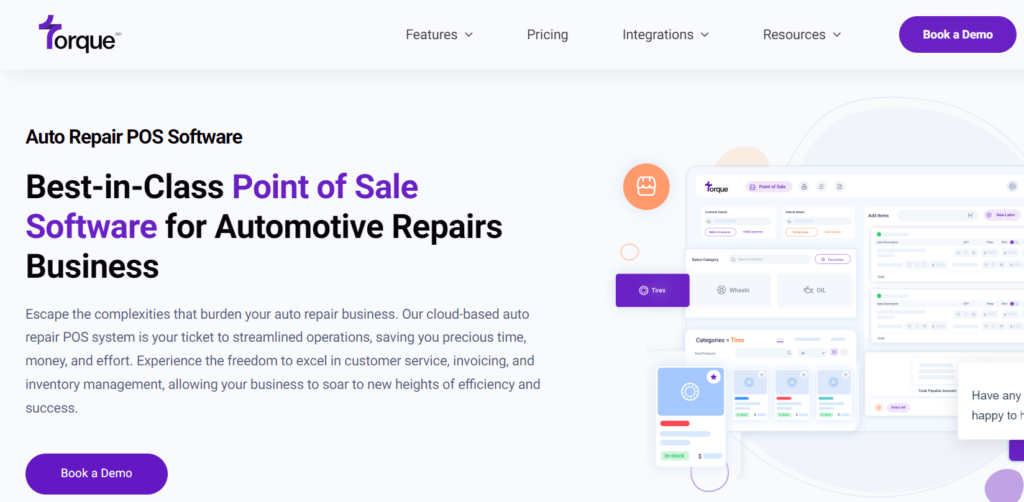Want to improve your shop efficiency?
You can do this by using simple yet effective mechanic shop organization ideas.
Improving your mechanic shop’s efficiency involves more than just speed.
It’s about coordinating tools, skills, and methods to ensure every repair job is precise.
Picture a world where tools never disappear on messy workbenches, parts stay organized, and every moment of searching equals more profit.
In this blog, we won’t just oil the wheels of your shop’s daily operations; we’ll supercharge your workspace with ingenious ideas and creative solutions that will have your mechanics working in seamless harmony. After reading this blog, you will not be out of office organization ideas for a mechanic shop.
Want to grow your mechanic shop? Book a personalized demo now.
7 Mechanic Shop Organization Ideas:
Here are seven super practical mechanic shop organization ideas that will take your business efficiency to the next level:
A good business can also help in increasing efficiency. Check out our blog on auto repair shop business plan.
Idea 1: Smart Tool Storage
In the heart of every thriving mechanic shop, an orchestra of mechanical prowess plays out daily.
The maestros?
But, just like any symphony, they need a conductor.
That’s where intelligent tool storage steps onto the stage.
In the bustling world of a mechanic shop, time is money. Every second spent rummaging through a disorganized toolbox is not spent working on the car. Efficient tool storage ensures that your tools are readily available when needed, minimizing downtime and maximizing productivity. You can also save time by using proper automotive scheduling software.
Let’s explore some of the ingenious solutions that turn your mechanic shop into a well-orchestrated masterpiece:
Wall-Mounted Pegboards:
Think of these as the art gallery for your tools. Wall-mounted pegboards provide an eye-catching display and create an easily accessible arsenal of equipment. No more digging through drawers or shuffling across the shop; everything you need is at your fingertips.

Magnetic Tool Holders:
If pegboards are the art gallery, magnetic tool holders are the magnetic poetry of your shop. They turn walls into garage storage space with a simple magnetic touch. Attach your most-used tools to these holders, making them instantaneously available and adding an artistic flair to your workspace.

Tips for Organizing and Labeling Tools
To truly master the art of tool storage, you need a few office organization ideas for a mechanic shop:
Labeling is Your Ally:
Invest in high-quality labels and tag each tool’s designated spot on your pegboard or magnetic holder. This way, there’s no guessing involved. Need a 9/16 socket wrench? You’ll know precisely where it lives.
Color Your World:
Consider color-coding your tools based on their functions. For instance, all electrical tools could sport a vibrant blue label, while your trusty socket set can proudly don the red label. This visual harmony will help your mechanics swiftly identify the right tool for the job.
Shadow It:
Create silhouettes or outlines of your tools on your storage system. This visual cue not only aids in organization but also serves as a quick inventory check. If a tool is missing, its absence is glaringly apparent.
Use a good auto repair shop software:
A good auto shop software can help you manage scheduling, invoicing, estimation, digital vehicle inspection, and more.
Idea 2: Workstation Optimization
Workshop optimization is another one of the best mechanic shop organization ideas.
In the world of mechanics, precision is paramount. Whether you’re fine-tuning an engine or resurrecting a rusted relic, your workstation is your canvas, and your tools are your brushes.
Imagine a painter trying to create a masterpiece using a single brush and a single color. It’s absurd, right? Similarly, in a mechanic shop, one-size-fits-all workstations are anathema to efficiency. Each task demands its stage, designed with precision in mind.
Modular Workbenches and Their Flexibility
Step into the modular workbench, the mechanic shop’s versatile masterpiece. These workstations are like a blank canvas, ready for your custom touch. Need a sturdy surface for engine repairs? No problem. Want an elevated platform for undercarriage work? It’s a breeze. Modular workbenches change to fit your needs so your workspace can keep up with your projects.
What makes modularity fantastic is its flexibility. You can add or remove shelves, drawers, and pegboard attachments whenever you need. These workbenches can grow or shrink like a chameleon, adapting to your workspace, making them the perfect tool for an efficient mechanic shop.
Suggestions for Organizing Workstations Efficiently
To optimize workstations like a seasoned artist, consider these brushstrokes of wisdom:
Task-Centric Design:
Tailor each workstation to its specific purpose. Create stations for engine diagnostics, suspension repairs, and brake jobs. Equip them with the tools and diagnostic equipment necessary for those tasks, eliminating the need for mechanics to wander the shop searching for what they need.
Ergonomics Matter:
Pay close attention to ergonomics. Adjustable workbenches allow mechanics to set the height that suits them best. Ergonomic seating ensures comfort during prolonged tasks. An ergonomic setup enhances efficiency and reduces the risk of work-related injuries.
Storage Solutions:
Equip each workstation with ample storage. Drawers, rollout shelves, and tool cabinets should be within arm’s reach, minimizing the time spent fetching tools or parts. Pegboards and magnetic holders on the workstation itself keep essential tools easily accessible.
Visual Cues:
Use visual cues like color-coding or labels to designate specific tool and part storage areas within workstations. This aids in quick identification and reduces the likelihood of misplaced tools.
Idea 3: Inventory Management
Imagine a workshop where spare parts and tools are scattered like leaves in the wind – a recipe for chaos.
To strike the perfect note of efficiency, you must first heed the call for effective inventory management.
Gone are the days of dusty ledgers and manual counts. Today, the digital realm offers a symphony of tools for managing your automotive shop’s inventory. It all begins with recording every last treasure in your shop. This isn’t just an organizational task; it’s the cornerstone of inventory management.
Introducing inventory software, your digital assistant for managing stock. It’s not just for tech whizzes; it’s a game-changer for everyone. These digital tools save time and help you stay organized, making sharing inventory details with your team easy. Start by choosing the right method for your shop; you can transition to inventory software when ready.

In inventory management, categorization and labeling take center stage. Here’s how to navigate this process:
Sort Smartly:
Divide your inventory logically, like sections in an orchestra. You can categorize by part types, brands, sizes, or functions, making it easy to find what you need.
Clear Labels:
Think of labels as your inventory’s sheet music. Use clear, concise labels, and consider color-coding for easy identification. This ensures your team can find items quickly and without any confusion.
Pro tip: To make the process less daunting, follow the Pareto Principle – focus on the most vital items that bring in the most profit or are in constant demand. Inventory these treasures first, then gradually waltz through the rest of your inventory when time permits.
Idea 4: Fluids and Chemicals Organization
Regarding mechanic shop organization, ideas, fluids, and chemicals are essential players.
Firstly, it’s all about safety. When dealing with these substances in a mechanic shop, it’s not just about being efficient; it’s about keeping your team and the environment safe. Organized storage ensures that these potentially dangerous materials are handled carefully.
Having a well-organized storage system also means you can easily track what you have. No more running out of important fluids during a job. It’s like having a storage room ready for your automotive magic.
Think of cabinets and shelves specially made for your fluids and chemicals. These aren’t just any storage solutions; they are there to keep your shop safe and efficient.
These are like super-secure vaults for mechanics. They’re designed to store dangerous chemicals safely with solid walls, good ventilation, and locks. This keeps flammable or toxic substances secure, protecting your team and the mechanical shop.
For non-hazardous but essential fluids, dedicated shelves are a lifesaver. They keep everything neat and easy to find. Mechanics can quickly grab the right bottle of engine oil without searching.

Let’s talk about labeling – it’s like the conductor’s baton in this organization symphony. Proper labels make sure everyone knows what they’re dealing with.
Useful Labels:
Put more than just the name on the label. Include things like expiration dates and safety instructions. It’s like giving your fluids and chemicals their passports.
Easy Access:
Keep the most-used fluids and chemicals within reach. This means less searching and more fixing.
Safety Training:
Teach your team how to handle chemicals safely. This isn’t just about efficiency; it’s about their safety and the safety of your workspace.
Idea 5: Vehicle Tracking and Scheduling
You can also get effective mechanic shop organization ideas with vehicle tracking and scheduling.
Imagine a shop where every vehicle repair is well-organized and every appointment is on time. Here’s why tracking repairs and scheduling appointments is so valuable:
- Tracking repairs means you always know what’s happening with each job. No more guessing if a car is fixed. This helps you use your resources wisely so you don’t waste time.
- When you schedule appointments accurately, show your customers that you respect their time. Satisfied customers become loyal ones.
- Efficient scheduling and tracking reduce wasted time and costs. You can use your workforce better, reduce overtime, and maximize your shop’s resources.
Now, let’s meet the digital tools that make vehicle tracking and scheduling easier:
Appointment Scheduling Software:
This software lets you manage appointments smoothly. Customers can book online, and your schedule updates in real-time to prevent double bookings or empty slots.
Repair Tracking Systems:
These digital systems show the progress of each vehicle’s repair. It keeps customers informed and helps your team work efficiently by knowing what needs attention and when.
If you need to learn about digital tools that can help you in your business, you should look for Torque360. It offers all-round automotive management software as well. It includes many features such as scheduling, invoicing, estimating, digital vehicle inspection, repair order management, technician portal, POS integration, and marketing solutions.
To make your scheduling and tracking process work well:
- Encourage customers to schedule routine maintenance. It keeps business steady and helps you plan your schedule better.
- When scheduling, group similar repairs together. It reduces switching between tasks, letting your team focus and finish jobs faster.
- Always leave some extra time between appointments. It gives room for unexpected delays or additional repairs and keeps customers from feeling rushed.
- Send automated appointment reminders to reduce no-shows. A gentle reminder through text or email helps keep your schedule on track.
Idea 6: Waste Disposal and Recycling
Underneath the dirty work clothes and the sounds of tools, there’s a responsibility – properly getting rid of car waste. It’s not just for your customers and shop; it’s for the environment, too. Here’s why it matters:
Car waste, like used oil and old tires, can harm the environment if not handled right. These pollutants can pollute the soil and water if not disposed of properly. Responsible disposal keeps these potential dangers under control and protects our planet.
Now, let’s see how recycling and eco-friendly practices can make your shop an environmental champion:
- Work with recycling centers that accept used oil. When recycled properly, it can be used again, avoiding environmental harm.
- Old car batteries have harmful materials. Connect with battery recycling programs to dispose of and potentially recycle them safely.
- Instead of throwing away scrap metal, think about recycling it. Metals like steel and aluminum can be melted down and used again, which reduces the need for energy-intensive mining.
- Choose eco-friendly automotive fluids and cleaners. These products are often biodegradable and less harmful to the environment.
Now, let’s discuss creating waste disposal stations in your shop to get better ideas for mechanic shop organization. It’s like giving your shop a place to be environmentally responsible:
Designated Areas:
Create specific areas for different types of waste. Make clear and easy-to-use recycling bins or containers for oil, batteries, scrap metal, and other recyclables.
Labels and Signs:
Put clear labels on each waste disposal station and use signs to inform your employees and customers about what can and can’t be thrown in each area.
Training and Education:
Teach your mechanics how to dispose of waste properly and explain why recycling is essential. Knowing what to do is key to keeping a responsible waste management system.
Regular Collection and Disposal:
Arrange for regular collection and disposal of waste through local recycling or waste disposal services. Certified professionals should handle hazardous waste to ensure safety.
Idea 7: Employee Collaboration and Communication
When it comes to mechanic shop organization ideas, good communication is essential.
It’s like the gearbox that keeps everything running smoothly, ensuring every task is done correctly. Effective communication leads to:
- Faster work completion.
- Better problem-solving.
- Increased safety.
- Improved customer service.
In short, the oil keeps your shop’s gears moving.
Tools for Communication
- Whiteboards: Think of a whiteboard as a canvas where you plan your shop’s work. Put one up in a visible spot to share tasks, deadlines, and critical notes. It’s a simple but effective way to keep everyone informed.
- Digital Messaging Apps: Bring your shop into the modern age with Slack or WhatsApp. They allow instant communication, file sharing, and dedicated channels for specific tasks or projects. No more shouting across the shop!
- Shop Management Software: Invest in software designed for managing shops. They often include messaging, task assignment, and job tracking features, making the workflow from customer intake to job completion smoother.
Organization Ideas For Mechanic Jack stands in a Shop:
Organizing mechanic jack stands in a shop is not just a matter of tidiness; it’s a crucial safety and efficiency concern. Here are some mechanic shop organization ideas to keep these vital tools in check:
Designated Storage Area:
Allocate a dedicated shop floor space in your shop for jack stands. Whether it’s a corner of the shop floor or a wall-mounted rack, having a designated area ensures they’re always in the right place when needed.
Size-Based Segregation:
If your shop uses various sizes of jack stands, sort them accordingly. Use labeled shelves or compartments to organize them by height and weight capacity. This way, mechanics can quickly grab the suitable stand for the job.
Visual Identification:
Consider using color-coded labels or tape to mark the weight capacity of each jack stand. This visual cue allows for rapid selection and minimizes the risk of using an inappropriate stand for a task.
Regular Inspection:
Implement a schedule for inspecting and maintaining your jack stands. This ensures they are always in good working condition when needed, preventing accidents and downtime.
Safety First:
Place safety guidelines and reminders near the jack stand storage area to reinforce the importance of proper usage and safety protocols.
FAQs:
A: Organize your mechanic shop by optimizing layout, managing inventory efficiently, fostering employee collaboration, using digital tools, and setting up proper waste disposal.
A: The average profit margin for a mechanic shop is around 20-30%, but it varies based on factors like location and services offered.
A: Make your auto repair shop profitable by improving efficiency, providing excellent customer service, effective marketing, specialization, offering maintenance programs, controlling costs, adopting technology, gathering feedback, networking, and staying updated on industry trends.
WRAPPING UP!
The above mechanic shop organization ideas can highly help you in improving the productivity and efficiency of your mechanic shop. This will lead to better revenue and business.
If you need to learn about digital tools that can help you in your business, you should look for Torque360. It offers all-round automotive management software as well. It includes many features such as scheduling, invoicing, estimating, digital vehicle inspection, repair order management, technician portal, POS integration, and marketing solutions.



